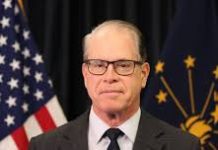The Pandemic Has Certainly Altered How We Live And Work
Greg Wathen, APR
CO-CEO Of The Regional Economic Partnership
The pandemic has certainly altered how we live and work, which is forcing us to adapt to a new normal. The phenomenon of working from home for example is something that will more than likely stick as the economy gets back to an even keel. For greater Evansville’s economy, remote work has a higher level of challenge for the manufacturing sector, which is the largest part of the region’s annual gross domestic product (GDP). Can manufacturing adapt to this changing landscape?
Many companies are rethinking what they believe is work and that will undoubtedly bring along with it new ways to integrate and use technology; and, in turn, will create a need and demand for reskilling workers. Along with reskilling, it’s important to make sure that any new business eco-system will preserve as well as grow diversity as there is a direct correlation between a more diverse team and higher financial performance. Â
The other, more significant phenomenon has been the residual fallout from COVID as inflation continues to rise with Americans finding themselves paying more for food, gas, and other basic essentials. There is also a continuing debate among economists and federal policy wonks over whether higher prices will be short-lived or will they stay for a much longer period of time.
The U.S. Commerce Department just reported that its personal consumption expenditure price index climbed 0.4% in May. The index is up 3.9% over the last 12 months, nearly double the Federal Reserve’s annual target of 2%. The latest figures echo as well other government data showing that inflation is increasing at its fastest clip since 2008. Â
As consumer demand picks up, will it outstrip the business capability of keeping up? Fed Chair Jerome Powell believes that although prices have turned up more sharply than expected, price increases will ultimately abate with the rise to be temporary. Quite a few economists have a much different view of the situation as Powell’s view is hardly unanimous.Â
Other policymakers and economists expect inflation to persist for months and possibly even years. Paul Ashworth, chief North American economist at Capital Economics, is not as certain as Chairman Powell. Bank of America’s top strategist, Michael Hartnett, “estimates that above-trend inflation could persist for years, driven in part by heavy federal spending.â€Â He sees inflation firmly in the 2-4% range over the next 2 to 4 years.
With inflation on the rise, U.S. businesses struggle to hire workers, especially lower-paid employees. In a recent article on the CBS News website, Chipotle Mexican Grill said that they recently boosted prices as much as 4% across its menu to help offset higher costs. The restaurant chain in May raised its average hourly pay to $15 for 100,000 workers. How many restaurants and businesses in the Evansville region have adjusted their compensation levels to manage their demand for workers? Â
The real question with all of the changes, how much are prices temporary, and how much will shift to greater permanency. More than likely, wage gains will begin to pick up steam as employees will demand higher wages to offset increasing costs for consumer goods. So many companies have either instituted or are considering price pass-throughs to customers to make up for what they are seeing within their supply chains. Fast rises in prices make for uncertainty in business and uneasiness for inflationary fears. The real question is this only the beginning or will the economy begin to settle. Only time will tell.Â





